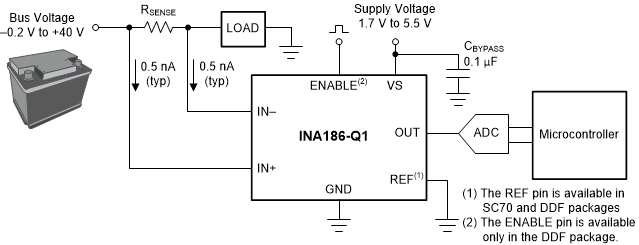JAJSHG8B May 2019 – March 2022 INA186-Q1
PRODUCTION DATA
- 1 特長
- 2 アプリケーション
- 3 概要
- 4 Revision History
- 5 Pin Configuration and Functions
- 6 Specifications
- 7 Detailed Description
- 8 Application and Implementation
- 9 Power Supply Recommendations
- 10Layout
- 11Device and Documentation Support
- 12Mechanical, Packaging, and Orderable Information
パッケージ・オプション
メカニカル・データ(パッケージ|ピン)
サーマルパッド・メカニカル・データ
- DCK|6
発注情報
8.1.1 Basic Connections
Figure 8-1 shows the basic connections of the INA186-Q1. Place the device as close as possible to the current sense resistor and connect the input pins (IN+ and IN–) to the current sense resistor through kelvin connections.

A. To help eliminate ground offset
errors between the device and the analog-to-digital converter (ADC), connect the
REF pin to the ADC reference input. When driving SAR ADCs, filter or buffer the
output of the INA186-Q1 before connecting directly to the
ADC.
Figure 8-1 Basic
Connections